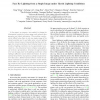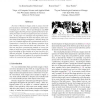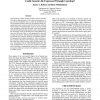291 search results - page 27 / 59 » Recent Advances in Face Recognition |
ICPR
2006
IEEE
14 years 12 months ago
2006
IEEE
Recent technological advances have enabled human users to interact with computers in ways previously unimaginable. Beyond the confines of the keyboard and mouse, new modalities fo...
CVPR
2007
IEEE
15 years 27 days ago
2007
IEEE
In this paper, we present a new method to change the illumination condition of a face image, with unknown face geometry and albedo information. This problem is particularly diffic...
CVPR
2008
IEEE
14 years 5 months ago
2008
IEEE
Two-tone (“Mooney”) images seem to arouse vivid 3D percept of faces, both familiar and unfamiliar, despite their seemingly poor content. Recent psychological and fMRI studies ...
ICIP
2007
IEEE
14 years 2 months ago
2007
IEEE
Although 2D-based face recognition methods have made great progress in the past decades, there are also some unsolved problems such as PIE. Recently, more and more researchers hav...
AAAI
2000
14 years 7 days ago
2000
Self-organizing models develop realistic cortical structures when given approximations of the visual environment as input, and are an effective way to model the development of fac...



